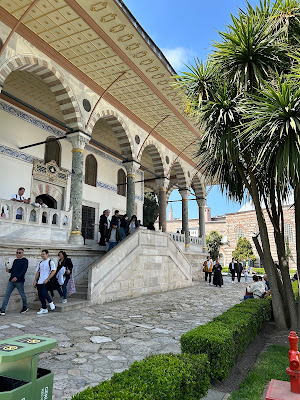We are still in the Second Court, the Court of Salutation. This is the view of the Divan (Dîvân-ı Hümâyûn, or Imperial Council in Turkish) where the highest bureaucrats of the Empire - The Grand Vizier and the chief ministers - met to discuss affairs of state. The location dates from Mehmet the Conqueror; the current building was built by his great grandson Sulyeman the Magnificent (and improved since then).
The grill in the wall was used by the Sultan to listen to the deliberations of the council. This practice ended in the reign of Suleyman the Great, when the Sultans ceased to attend the council at all.
Passing through the Second Court, one comes through the Gate of Felicity (Avlu), into the Third Court, known as the Inner Court (Enderûn Avlusu) in contrast with the Second, or Outer Court (Enderûn). This court housed the living quarters of the Sultan and his family. Entrance here was only by the authorization of the Sultan; even the Grand Vizier could not enter without authorization.
Below is the entrance to the Audience Chamber, or Chamber of Petitions (Ars Ordasi). Sadly, no pictures were allowed. Here the Sultan would formally receive visitors and gifts
The Inner Court. Surrounding the parklike square were the quarters of the Agas (page boys). The building in the middle with the domes is the Imperial Treasury
The building in the corner is the Imperial Treasury:
Rear view of the Chamber of Petitions:
The Fourth Court was known as the Imperial Sofa (Sofa-ı Hümâyûn) and was the living quarters of the Sultan and his family. We only went as far as the Third Court.




















Thanks for sharing your travels TB. One thing I noticed... the Conqueror....the Magnificent....the Great....nobody ever called the Adequate?
ReplyDeleteYou are welcome, Nylon12.
DeleteOf note, they were all not known in the positive. One of lesser well respected Sultans was Selim II, known to history as "Selim the Sot". He was the son of Suleyman the Magnificent. Charitable, lover of poetry, a poet himself - he had a bit of a drinking problem.
I can't come up with a question after reading Nylon12's comment.
ReplyDeleteEd, there were a total of 36 Ottoman Sultans. Not all of them got such nifty titles - in fact, several of them were deposed, confined, or outright killed. The nom de guerre's become a bit less fantastic as the Ottomans declined.
DeleteThat makes a lot of sense. It is sort of a survivor bias. The "Greats" and the "Magnificents" survived the passage of time while the "Sots" and the "Evils" were quickly forgotten.
DeleteWhat beautiful photos to share. I also learned something today so thank you.
ReplyDeletewww.rsrue.blogspot.com
Thank you - both for the compliment and for taking the time to comment!
DeleteHistorical European architecture ain't got nothin' on these folks. Truly amazing. Sadly, over here, we're far too quick to tear things down.
ReplyDeleteLeigh, arguably one of the great acts that Mustafa Kemal Ataturk did upon the establishment of the Turkish republic was to make many of the former Imperial properties and many other public buildings museums, thus preserving them from remodeling.
DeleteWe will see a few more elements of such architecture on the trip.
TB, what is the attitude there concerning Ataturk? I was in Antalya in 1991, courtesy of the US Navy, and he was still much-beloved. The country has become less secular; has that affected their view of the Father of Modern Turkey?
ReplyDelete--Tennessee Budd
T_B, interesting question. As last year was the 100th anniversary of the Turkish Republic, Ataturk's picture was everywhere. He appeared (at some point) in almost every museum we were at. His face decorates schools and a speech of his is there as well. I think on the whole, he is still very respected for what he did.
DeleteThat said, there are (as you note) undercurrents of religious fervor. To the secularists of Turkey - or not even secularists, but even non-fundamentalists - he has become even more of a symbol of modern Turkey and respected. Our guide, who was more or less in my age bracket (and a relative secularist) always spoke very respectfully of him.
We did visit his mausoleum in Ankara. It was rather...overwhelming.